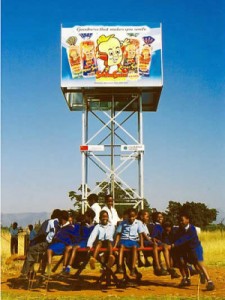How PlayPumps are an example of learning from failure | Source: Tom Murphy, Humanosphere – July 2013 |
PlayPumps are a go-to example of failed aid interventions.
The merry-go-round powered by playing children pumped water out of the ground. The idea was that children filled with energy could have something to play with that also provided water for a community.
Problem was that it did not end up working out as planned. The PlayPumps needed to spin all day long in order to provide enough water for a community. That meant children and adults were no playing, but walking endlessly in circles to get the water out of the ground. 
The over-hyped idea failed spectacularly. It has been used countless times to illustrate how aid programs can fail. Justin Sandefur and Charles Kenny from the think tank the Center for Global Development, recently mentioned PlayPumps in an article for Foreign Policy to illustrate how technical solutions can fail.
An innovation hailed by Laura Bush and AOL co-founder Steve Case that would use the power generated by kids spinning on a merry-go-round to deliver water. PlayPumps cost four times what a regular water pump did. Aid workers reported that they broke and were hard to fix. And, according to an analysis by the Guardian, it turned out that kids would have to “play” for 27 hours a day to meet the target of delivering water to 2,500 people per pump.
Innovations are important to finding development solutions, say Sandefur and Kenny. The problem is making sure that they are tested and either shelved (if they fail) or scaled (if they succeed). The thing is that PlayPumps may be an example of how an attempt to innovate on delivering water to communities failed, learned and improved.
Ned Breslin, CEO of the water NGO Water for People, responds in the Stanford Social Innovation Review by pointing out that Silicon Valley does not have a monopoly on overselling technological solutions that fail to address complex development problems. Other failed water projects include multi-chambered water filters, superchlorinators, deep-borehole hand pumps, bizarre latrines, and funky hand-washing contraptions, lists Breslin.
The thing is that failure is a part of innovation and the important part is whether people learn from their mistakes rather than making the same ones over and over. Turns out that PlayPumps learned. The Case Foundation, the funders behind PlayPumps ended the program and improved how they addressed the problem of water access.
So what did they do differently? Breslin lists:
- Jean Case acknowledged the flaws of PlayPumps with honesty and transparency. She recognized the technology’s failures and took responsibility in addressing the major concerns.
- Not content with simply acknowledging the mistake, the Case Foundation pivoted its programming, effectively dumping the flashy technology and instead focusing on a specific outcome: running water for children in schools. This led to the installation of more effective, government-approved technologies in schools, thus allowing children to focus on learning rather than pumping water all day.
- The foundation monitored its work, regularly returning to the field to rectify shortcomings and implement new programming.
Turns out that the go-to example for failure is also a strong example for learning. This is the heart of innovation, says Breslin. Silicon Valley will not save the world, but it will teach aid organizations a thing or two.
“The real question is whether ideas on development, generated from non-traditional places such as Silicon Valley, can help push the needle. The answer to that, of course, is yes,” concludes Breslin.


